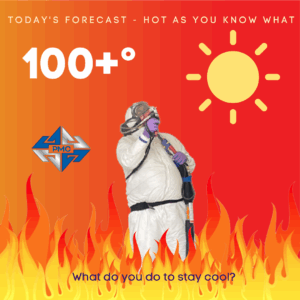Spraying foam insulation is tough, rewarding work, but in the heat of summer, it can also be dangerous. Between the heavy PPE (personal protective equipment), the confined spaces, and the physical effort required, sprayers are at high risk for heat-related illnesses. Staying cool and hydrated isn’t just about comfort—it’s about safety.
Here are 10 tips to help you beat the heat and recognize the signs of heat exhaustion and heat stroke before it’s too late.
1. Start Hydrated and Stay Hydrated
Begin drinking water before you even start your shift. Continue sipping throughout the day—don’t wait until you feel thirsty. Sports drinks with electrolytes can help replace lost sodium and potassium, especially during long jobs.
2. Take Regular Cool-Down Breaks
Schedule short breaks in a shaded or air-conditioned area. Even five minutes out of your PPE to let your body breathe can lower your core temperature.
3. Wear Cooling Gear
Consider cooling vests, neck wraps, or moisture-wicking underlayers beneath your protective suit. These can make a big difference when working in enclosed spaces.
4. Work in Shifts During Peak Heat
If possible, adjust your schedule to avoid spraying during the hottest part of the day (typically between 11 a.m. and 4 p.m.). Early mornings and evenings are safer. Operating a machine such as the Premier Mach 2 will enable you to get the job done twice as fast.
5. Maximize Ventilation
Use fans or portable air movers to keep air circulating. Better airflow means less heat trapped inside your suit and workspace.
6. Monitor Body Temperature
If you have access to a forehead or ear thermometer, check yourself during breaks. Anything above 100.4°F could be an early warning sign to slow down and cool off.
7. Know the Signs of Heat Exhaustion
- Heavy sweating
- Weakness or fatigue
- Dizziness or headache
- Nausea or vomiting
- Muscle cramps
If you or a team member experience these symptoms, stop work, move to a cool place and drink fluids immediately.
8. Recognize the Danger of Heat Stroke
Heat stroke is a medical emergency. Call 911 immediately if someone has:
- Hot, dry skin or excessive sweating that suddenly stops
- Confusion, slurred speech, or seizures
- Loss of consciousness
- A body temperature above 103°F
While waiting for help, move the person to a cool location, remove excess clothing, and use cold packs or wet towels to bring their temperature down.
9. Buddy Up
Assign partners to check on each other throughout the day. Heat illness can sneak up quickly, and sometimes others notice symptoms before you do.
10. Maintain Your Equipment
Well-maintained spray equipment runs more efficiently, reducing downtime in hot conditions. Preventative maintenance also means fewer emergency repairs which can often happen in less-than-ideal environments.
Your safety is worth more than any deadline. By staying cool, staying hydrated, and watching out for each other, you can keep yourself and your crew safe while delivering top-quality spray foam insulation work.
Polyurethane Machinery Corporation is here to support you with reliable, durable spray equipment that works as hard as you do—even when the temperature climbs.

